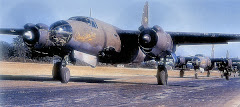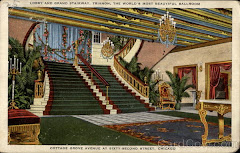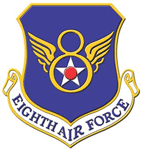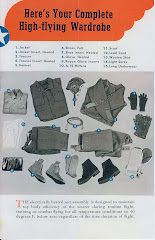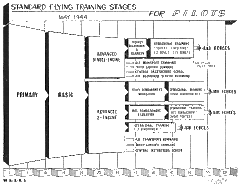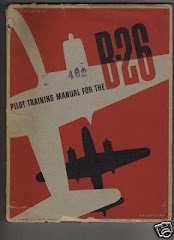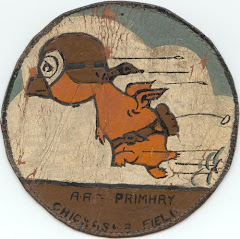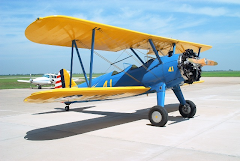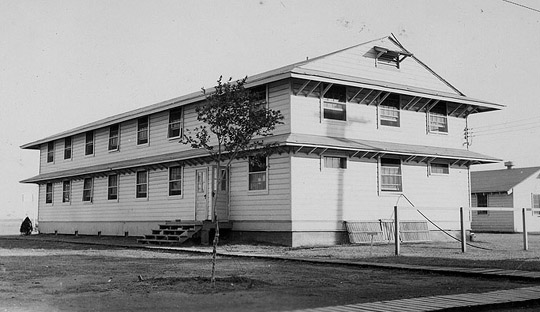We flew our first mission on March 5, 1944. We were told never to talk about our missions, everything was very secret. We never knew where we’d be going until we went to our briefing sessions before each mission and got our assignments. Although, mostly we knew we’d be going over Holland, Belgium, France (all occupied by Germans at that time) or to Germany itself. The B-26s were assigned both primary and secondary targets. Our mission was to get in, drop the bombs and get out.
The targets included marshalling yards, roads, bridges, ammunition dumps, power stations and shipyards. We flew in formation in what they called boxes. The mission leader flew in the middle of the first row with #2 plane on his right and #3 plane on his left. Directly behind the leader was #4 with #6 on his right side and #5 on his left side.
Usually the leader was the only plane with what they called the Nordin Bomb Site. That was a special navigation instrument for locating your exact target. They weren’t very plentiful at the time and every plane in the formation was to watch the leader – when he dropped his bombs you dropped yours. If no one had a Nordin, everything was done by sight navigation.
B-26 In Flight
B-26s in Formation, Flak Exploding
We flew seven missions in March and twelve missions in April. On non-mission days we were doing a lot of training now that we understood what combat was. The crew always wore parachutes in case we were hit and had to abandon the ship. Medium level (altitude) bombing meant we were flying in the range of 8,000 to 10,000 ft. At 10,000 feet you had to wear your oxygen mask. It got pretty cold at those altitudes. We were dressed in uniforms with electric wires that we could plug in to get warm.
The biggest hazard was the anti-aircraft (ack-ack) guns being shot at us from the ground. We were doing daylight bombing and you could see it exploding all around you plus it created wind bumps every time it was close. Eventually there were diversionary tactics that we took at higher altitudes. The whole formation had to follow the same orders. Trying to divert to avoid ack-ack on our own would put the formation at risk of colliding with each other so there was no dodging bursts on your own. It made for raw nerves most of the time. The second hazard was actual attack by the Luftwaffe. That’s when our fighter planes (mostly RAF Spitfires) were supposed to protect us. So far we’d managed to escape both the ack-ack and the attacks with very little damage. We were also doing a fairly good job of hitting our targets.
One of our missions was called a “Grudge Raid.” You remember that the original B-26 low-level flying over Holland targets had been a disaster. They were flying right down on treetop level when they flew those first missions. One of the targets had been a power station, the other a U-boat base – both in the Netherlands. It was just across the border from France. Holland was occupied by Germany but the people of Holland were our friends. On that mission, the Command had decided to warn the people of Holland they were coming, so they broadcast the raid on the radio. Of course the Germans heard it too and were prepared for them. Nazis were even up in the tops of the Church steeples shooting at them. The Germans managed to knock out all but one or two of the B-26s and only a few men got back. I think about 60 were lost or missing. I heard that 24 ended up in German POW camps.
The Grudge Raid was targeting the same installations but this time we would be flying at 12,000 feet. That was our best altitude because by then they had found out it took the Germans seventeen seconds to track us and get a shell up to us at that altitude. Therefore, we never flew in a straight line for more than 15 seconds. Many times we could see big black clouds of exploding shells right where we would have been had we flown straight for another two seconds. I called that cutting it close. There were 300 B-26s on this Grudge Raid on the U-Boat installation.
The first week in May the 322nd threw quite a celebration when one of the B-26 planes, named the “Mild and Bitter” became the first bomber of the Allies to complete100 missions. Not only that, it had never lost an engine or sustained major damage and no crewman had ever been hurt on those missions. We weren’t assigned the same plane every time we flew, so over 166 men on the base had flown a mission on the Mild and Bitter at one time or other. It was the pride of the 9th Army and it was a big celebration. By the end of July there were a total of 10 B-26s in the 322nd that made it to 100 missions, a real tribute to their dependability. (After the disastrous start in Holland in ‘43 the B-26s ended the war with under 1% combat losses.)
About that time Command decided that we would do some night time training in formation flying. Our crew Captain, Lt. Davison decided that it was too dangerous to fly formation at night. He went to the Squadron Commander and told him he wouldn’t do it. The Commanding Officer called me in and told me what Davison said. He asked me what I thought about night flying. I said I thought it couldn’t be much more dangerous than flying over enemy territory in broad daylight and having anti-aircraft shells exploding all around us. He demoted Lt. Davison to co-pilot and made me crew commander. He assigned the same crew to me and gave me a new co-pilot by the name of Jimmie Deloach. Lt. Davison would be flying co-pilot with the C.O. from then on. It turned out we practiced some night flying but we never did actually fly any night time missions while I was there.
We flew another twelve missions in May. Most of them were on railroad yards and fuel dumps near cities along the coast of France that were occupied by the Germans. Our missions were not much over four hours long because even though we carried about the same bomb load as the B-17s (which had 4 engines to our 2) we only had about four and a half or five hours of fuel. Even though flight time averaged about 4 hours, there was about 3 1/2 hours prep time before leaving and some check out time after so there was a lot of tension and adrenaline flowing on mission days and it was always a relief to get back.








